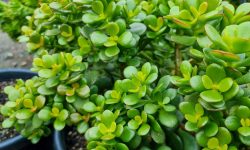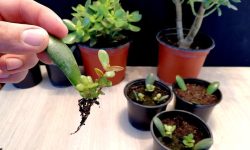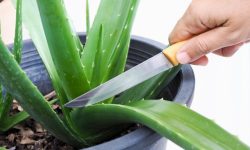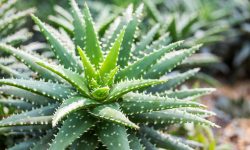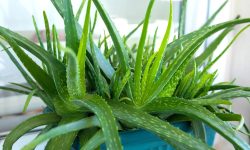Pruning a jade plant may seem simple, but the process becomes powerful when done with intention and timing. These succulents grow slowly yet respond quickly to precise cuts, especially when new growth begins forming along the stems. Many growers want fuller, bushier jade plants with well-balanced shapes, but this result only appears when pruning supports the plant’s natural rhythm. Each cut sends a signal to the plant, redirecting energy toward fresh growth. When you understand how the plant reacts to pruning, you can shape it with confidence and avoid common mistakes. Proper pruning creates a strong foundation that supports growth for many years.
Encouraging new branching requires more than cutting stems. Jade plants depend on balanced light, controlled moisture, and stable conditions to produce strong new shoots. A healthy plant always responds better, so pruning becomes a part of an overall care strategy rather than a single action. When done correctly, the plant forms compact nodes, thicker stems, and improved structure. These changes help prevent leaning and keep the plant visually appealing as it matures. Pruning also protects the plant from breakage by removing weak or stretched branches. With the right approach, pruning becomes an easy and rewarding practice that transforms the entire plant.
Understanding How Jade Plants Respond to Pruning

Jade plants react to pruning through a natural growth pattern that directs energy toward new nodes. When a stem is cut, the plant senses a loss of its growing tip and immediately begins forming new points of growth nearby. This reaction comes from the plant’s ability to redistribute hormones that control branching. A precise cut encourages the plant to form two or more new shoots in the same area. These shoots eventually strengthen the plant and create a fuller structure. Understanding this built-in response allows you to prune with purpose.
The plant’s reaction depends heavily on its health and environment. Strong jade plants with firm leaves respond quickly by producing new buds within several weeks. Weak plants react slowly, especially when moisture, light, or temperature conditions remain unstable. Jade plants require bright indirect light to activate branching hormones and maintain steady growth. Good lighting also prevents new stems from stretching. When the environment stays balanced, pruning stimulates compact and controlled growth. This balance helps the plant recover quickly and redirect its energy with efficiency.
Timing plays an important role in how well the jade plant responds to pruning. The most active growth occurs during warmer months, so pruning during this period gives the plant more energy to form new branches. Pruning during slow seasons leads to delayed growth and weaker response. A jade plant also reacts better when it has consistent moisture and strong roots. Healthy roots support new tissue and help the plant recover from cuts. By pruning at the right time and under the right conditions, you encourage predictable branching and create a stronger, more resilient plant.
Choosing the Right Tools and Preparing the Plant
Choosing the right tools makes pruning smoother and safer for your jade plant. Clean, sharp tools create clean cuts that heal quickly and reduce the risk of infection. Dull blades crush tissue, which slows healing and increases stress. Many growers prefer small pruning shears or sharp scissors because they offer precise control. Before trimming, clean your tools with alcohol to remove bacteria. This step prevents pathogens from entering the fresh cuts. Good preparation ensures every cut supports healthy growth and reduces complications.
Preparing the plant before pruning improves the response and protects new tissue. A jade plant should be healthy, well-lit, and properly hydrated before any trimming. When the plant receives bright indirect light for several weeks, its stems become stronger and more responsive to shaping. Avoid pruning a stressed or dehydrated plant because recovery becomes slower. Checking the stems for firmness helps you identify the right areas to trim. Firm stems show stable moisture balance, while soft stems require more care before pruning. Proper preparation ensures the plant reacts with predictable growth.
Positioning also plays a role in successful pruning. Place the plant where you can view its shape clearly from all sides. This angle helps you choose the best stems to trim and prevents uneven shaping. A full view of the plant also reveals weak or stretched branches that need removal. Once positioned, examine how light reaches the plant, because pruning should enhance future light distribution. A well-prepared jade plant responds faster, forms new growth more evenly, and maintains a balanced structure. Careful preparation supports strong branching and long-term stability.
Knowing Where to Cut for Maximum Branching
Understanding where to cut determines how effectively your jade plant forms new branches. Each stem contains nodes that act as natural growth points. When you cut above a healthy node, the plant channels energy into that area and produces new shoots. These shoots become future branches that build a fuller shape. Selecting a firm, mature section of stem ensures the plant responds quickly. Avoid cutting too close to the base because low cuts often slow branching. Choosing the right spot increases the number of new growth points.
The height of each cut also affects the final structure. Higher cuts encourage upward growth, while mid-level cuts promote wider branching. If your plant looks tall and thin, trimming the upper stems encourages a more balanced shape. When you remove the growing tip, hormones shift downward and awaken dormant nodes. This shift produces stronger branching and prevents the plant from becoming leggy. Observing the plant’s structure before trimming helps you find the most effective locations. A well-planned cut shapes the plant with accuracy.
Healthy branches provide the best response, so choose stems with firm leaves and consistent color. Avoid cutting damaged or weak stems because the plant may struggle to produce new growth there. Instead, remove unhealthy sections entirely to direct energy toward stronger areas. Good lighting and stable moisture help activate the nodes after pruning. When conditions stay balanced, new shoots appear within weeks. Knowing where to cut gives you full control over the plant’s form and helps create a dense, compact jade plant that continues growing with strength and stability.
Making the First Cut: Technique and Timing
Making the first cut sets the tone for how your jade plant will grow in the following weeks. A clean, deliberate cut encourages the plant to redirect energy toward new buds. Hold the stem firmly and cut just above a healthy node so the plant knows where to send its next growth. Cutting too far above a node leaves unnecessary stem length that may dry slowly. Cutting too close risks damaging the node itself. A balanced position creates ideal conditions for new branching. Technique matters because clean tissue recovers faster and forms healthy new growth.
Timing also influences how well the plant responds. Jade plants react best when pruned during warm months because the plant remains active and ready to grow. The increased light encourages fast cell production, which helps the cut area heal. Avoid pruning during cold seasons because the plant slows down and produces weak growth. Early spring and early summer provide the strongest results. During these times, the plant has more energy and responds quickly. Correct timing ensures that each cut leads to predictable branching.
After making the first cut, observe the plant closely for changes. The cut area begins forming a protective layer that prevents moisture loss. Within several weeks, small buds begin forming near the node. These buds develop into branches that strengthen the plant’s structure. Avoid watering the plant immediately after pruning because wet soil can slow healing. Instead, let the plant rest in bright indirect light. Stable lighting helps the plant focus on recovery and new growth. When technique and timing align, the first cut becomes the foundation for bushier and healthier development.
Encouraging New Branches After Pruning
Encouraging new branches begins with creating the right environment after trimming. Once the plant receives its first cuts, it needs steady light and controlled moisture to activate dormant nodes. Bright indirect light signals the plant to start producing new shoots. Light also prevents elongated growth and keeps new stems compact. Jade plants rely heavily on stable lighting to develop strong and healthy branches. When light stays consistent, the plant responds quickly and forms balanced new growth. This simple adjustment supports faster branching.
Moisture control is equally important during this stage. Newly pruned plants cannot handle heavy watering because fresh cuts increase sensitivity. Allow the soil to dry before each watering to avoid stress. Dry cycles encourage the plant to strengthen its root system and support new branch formation. Overwatering slows growth and weakens new tissue. Keeping the soil slightly drier helps the plant recover. Jade plants prefer gradual hydration, especially after pruning. A consistent routine encourages young shoots to grow with stability and firmness.
Supporting new branches also requires regular observation. As new buds appear, ensure each one receives enough light and space to develop. Rotate the plant to maintain even growth and prevent leaning toward one side. Good airflow around the plant protects young shoots from fungal issues. Avoid fertilizing too early, because new tissue reacts poorly to strong nutrients. Wait until the branches form firm leaves before feeding. When these conditions stay balanced, the jade plant produces multiple branches that create a fuller, more attractive shape. Proper aftercare ensures every pruning effort leads to healthy and predictable branching.
Shaping the Plant for Long-Term Structure
Shaping a jade plant after pruning helps it develop a strong and balanced long-term structure. These succulents naturally grow upward, but controlled shaping encourages outward branching. When you guide growth in several directions, the plant forms a wider base and stronger framework. This structure prevents leaning and supports heavier branches as the plant matures. Shaping also helps the plant distribute weight evenly, which reduces the risk of breakage. Early shaping decisions often determine the plant’s future growth pattern.
The best shaping results come from consistent adjustments rather than large changes. After new branches form, observe how they develop and decide whether they should grow longer or be shortened. Trimming small sections of new growth stimulates additional branching near the tips. This technique helps create a dense and compact form. Spacing also matters because crowded stems block airflow and reduce light penetration. Ensuring that each branch has room to grow leads to a healthier structure. When shaping remains steady and patient, the plant responds with confidence.
Environmental support plays a major role in successful shaping. Bright indirect light encourages branches to grow evenly on all sides, preventing the plant from leaning. Rotating the plant every few weeks ensures each branch receives equal exposure. Controlled watering also strengthens stems and prevents weak, overhydrated growth. When shaping aligns with proper care, the jade plant develops a stable trunk and strong branching system. This long-term structure supports healthy growth for many years and creates an attractive, well-balanced appearance. A shaped jade plant reflects thoughtful care and grows more predictably in every season.
Preventing Stress and Damage During Pruning
Preventing stress during pruning helps your jade plant respond with stronger and healthier growth. These succulents tolerate shaping well, but sudden or aggressive cuts may slow recovery. The plant must be in stable condition before any trimming begins. Firm leaves, bright color, and steady hydration show readiness for pruning. Avoid pruning when the plant struggles with low light or fluctuating temperatures. Stable conditions reduce shock and help the plant redirect energy smoothly after cuts. Preventing stress early creates a calmer recovery process.
Damage often occurs when tools are dull or cuts are placed incorrectly. A clean cut heals faster and encourages new growth near the node. Crushing or tearing the stem delays healing and increases the risk of rot. Ensuring your tools are sharp and disinfected protects the plant from infection. Handling the plant gently while pruning also prevents accidental leaf loss. Avoid bending stems excessively because jade branches snap easily when stressed. Careful handling keeps the plant’s structure intact and supports long-term health.
After pruning, the plant must have a stable environment to heal without interruption. Bright indirect light strengthens new tissue and prevents stretching. Avoid heavy watering because too much moisture weakens fresh cuts. Letting the soil dry supports natural recovery and reduces stress. Good airflow also helps protect exposed tissue from fungal problems. Observing the plant each day helps you adjust care if signs of stress appear. When stress is avoided, the jade plant produces new branches quickly and maintains firm, healthy leaves. This balanced approach ensures each pruning session improves the plant’s structure and future performance.
Maintaining Proper Care After Pruning
Maintaining proper care after pruning ensures the jade plant continues growing with stability and strength. Pruning changes how the plant distributes energy, so consistent care becomes even more important during recovery. Bright indirect light helps new shoots form thick and compact leaves. Avoid exposing the plant to strong sunlight because new tissues burn easily. Controlled lighting allows the plant to rebuild energy and form new growth patterns. When conditions remain stable, the plant adjusts quickly and responds with healthy branching.
Watering also plays a major role in post-pruning care. Fresh cuts increase sensitivity, so moisture must remain balanced. Water only when the soil becomes fully dry, because wet soil slows healing and encourages rot. Allowing the soil to dry supports root strength and prevents weak growth. New branches need firm structure, which forms best under moderate moisture. When watering stays controlled, the jade plant maintains consistent internal pressure. This routine helps stabilize new branches and prevents soft or elongated growth.
Additional support includes monitoring airflow, temperature, and overall plant condition. Good airflow reduces humidity and protects new tissue from fungal issues. Stable temperatures prevent stress, especially during early recovery. Avoid fertilizing immediately because new tissue reacts poorly to concentrated nutrients. Wait until the plant forms firm leaves before adding diluted fertilizer. Rotating the plant every few weeks encourages balanced branching and prevents leaning. Observation remains essential because early signs of stress help guide adjustments. When post-pruning care stays consistent, the jade plant becomes fuller, stronger, and more resilient.
Shaping Mature Jade Plants Without Causing Shock
Shaping mature jade plants requires extra care because older stems respond differently from young growth. Mature branches become woody and hold more stored moisture, so they react slowly to sudden changes. Cutting these thick stems without preparation may cause stress or delayed growth. Examining each branch helps you understand which areas need shaping and which should remain untouched. When the plant is shaped gradually, the structure becomes stronger and more balanced. Patience ensures the plant maintains stability during every stage of shaping.
Older jade plants also need a steady environment before shaping begins. Bright indirect light helps the plant stay active and ready to form new tissue. Mature branches heal more slowly, so stable temperatures encourage smoother recovery. Avoid pruning when the plant experiences stress, such as sudden watering changes or cold drafts. These conditions make the plant less responsive and delay healing. When the plant remains healthy, shaping becomes easier and more predictable. Observing leaf firmness and color helps confirm readiness for trimming. Clear signs of strength indicate the plant can handle shaping.
The technique for shaping mature plants focuses on small adjustments rather than large cuts. Removing only a few sections at a time allows the plant to redirect energy without shock. After trimming, support new growth with consistent lighting and controlled moisture. Avoid fertilizing immediately because mature plants respond slowly to added nutrients. Gentle observation during the recovery period helps detect early signs of stress. When care stays consistent, mature jade plants produce stronger branches and maintain attractive forms. Slow shaping helps preserve the plant’s natural beauty and supports long-term structural quality.
Correcting Overgrown or Leggy Jade Plants
Correcting an overgrown or leggy jade plant begins with understanding why the plant stretched in the first place. Most jade plants become leggy when they lack bright indirect light for long periods. The stems grow longer as the plant searches for stronger light, creating thin and unbalanced growth. Correcting this problem requires a combination of pruning and improved lighting. Once the environment supports steady light, the plant redirects energy toward compact growth. Balanced conditions help restore the plant’s natural shape and strength.
Pruning plays a major role in reshaping leggy stems. Cutting long branches encourages the plant to form new nodes closer to the base. These new points develop into compact branches that strengthen the plant’s structure. When you shorten overly tall stems, the plant no longer leans or bends under its own weight. Removing weak tips also reduces the chance of breakage. Allowing the plant to recover between each trimming session prevents shock. Over time, consistent pruning replaces stretched growth with firm and balanced branching.
After shaping, the plant needs an environment that prevents stretching from returning. Bright indirect light keeps internodes short and encourages thicker leaves. Rotating the plant helps ensure even exposure and prevents one-sided growth. Allowing the soil to dry between waterings strengthens stems and prevents soft, weak tissue. Avoid heavy fertilizing during early recovery because it may force rapid, leggy growth. With stable care, the jade plant begins forming compact branches that replace the elongated sections. Correcting legginess becomes an opportunity to reshape the plant and guide it toward long-lasting structural health.
Reviving a Pruned Jade Plant That Isn’t Branching
Reviving a pruned jade plant that refuses to branch requires patience and a careful look at the environment. Even healthy jade plants sometimes take longer to activate nodes after pruning, especially if conditions shift suddenly. The plant may pause growth while adjusting to the cut surface. Observing leaf texture helps you understand its condition. Firm leaves show stability, while soft or wrinkled leaves signal deeper stress. Correcting environmental issues encourages the plant to begin branching again. Controlled conditions give the plant confidence to restart growth.
Light remains the primary factor influencing new branching. A jade plant that receives weak light often delays bud formation because it lacks enough energy to build new tissue. Moving the plant to a brighter location helps activate dormant nodes. Bright indirect light strengthens internal processes and stimulates fresh growth. Temperature also plays a role because cold rooms slow recovery. Warm, stable conditions help the plant use stored moisture and direct energy toward new shoots. Once the environment aligns with the plant’s needs, nodes begin swelling and preparing for branching.
Moisture balance influences recovery as well. Overwatering after pruning delays growth by weakening the plant’s natural rhythm. Allowing the soil to dry fully before watering encourages healthy root function. Dry cycles give the plant the stability needed to form strong, compact branches. Avoid fertilizing too early because excess nutrients overwhelm new tissues. Instead, wait until clear signs of growth appear along the stem. Once new buds emerge, gentle feeding supports stronger branching. When revived under the right conditions, the jade plant resumes growth with greater resilience and improved structure.
Avoiding Common Mistakes When Pruning Jade Plants
Pruning Too Aggressively or at the Wrong Time
Pruning too aggressively places unnecessary stress on jade plants because these succulents grow slowly and rely on stored moisture within their leaves. When too many branches are removed at once, the plant struggles to redirect energy toward healing. Each cut demands resources, and heavy pruning forces the plant to distribute its energy across too many wounds. This slows recovery and delays branching. Gentle, controlled pruning allows the plant to focus on repairing each cut properly. Warm seasons remain the safest time to prune because the plant stays active and responds more quickly to shaping.
Pruning during colder months causes slow healing because growth naturally decreases when temperatures drop. Jade plants conserve energy in winter and produce limited new tissue. This reduced activity makes winter pruning risky and unpredictable. Soft lighting during cold seasons also delays recovery and encourages stretched growth. Planning pruning sessions during early spring or early summer ensures better results. At these times, the plant receives more light and maintains healthier hydration. When pruning remains gentle and appropriately timed, the jade plant responds with compact growth and more stable branching.
Using Improper or Unclean Tools During Pruning
Using improper or unclean tools creates long-lasting problems for jade plants because damaged tissue becomes vulnerable to infection. Dull blades crush stems rather than cutting them cleanly, leading to uneven wounds that dry slowly. Slow healing increases the chance of bacteria entering the cut surface. Cleaning tools with alcohol removes contaminants and protects the plant from hidden pathogens. A jade plant heals more effectively when cuts remain clean and precise. Preparing sharp, disinfected tools ensures every cut supports healthy branching and fast recovery.
Unclean tools also transfer disease between plants, especially when fungal spores remain on blade surfaces. Many growers underestimate this risk and prune several plants without disinfecting their tools. This habit spreads problems quickly and weakens healthy plants. Sharp tools create controlled cuts that trigger proper hormonal responses and encourage new growth near nodes. Poor-quality tools disrupt this natural process and limit branching potential. Investing time in maintaining tools ensures safer pruning sessions and healthier long-term development. Clean, precise cuts make shaping easier and help the jade plant maintain strong structure.
Creating Environmental Stress After Pruning
Environmental stress after pruning disrupts the plant’s ability to heal properly and slows new growth from forming. One common mistake involves watering too soon after trimming, which exposes sensitive cut surfaces to moisture. Jade plants require dry conditions to strengthen tissue and prevent rot. Allowing the soil to dry completely supports healthy root function and reduces stress. Overwatering slows internal processes and weakens the new tissue. Maintaining a consistent watering routine helps the plant focus on forming compact and stable branches during early recovery.
Light levels also influence the plant’s response after pruning. Weak light often delays branching and encourages thin, stretched growth. Bright indirect light stimulates dormant nodes and helps new shoots form strong leaves. Temperature plays a role as well because jade plants react poorly to sudden environmental shifts. Cold drafts or rapid heating changes interrupt recovery and may cause leaf drop. Steady airflow prevents fungal issues on new tissue and helps the plant maintain balance. Monitoring these factors daily ensures smoother healing. When environmental conditions stay controlled, the jade plant produces firm new branches and maintains long-term structural health.
FAQs About Prune a Jade Plant
Why isn’t my jade plant branching after pruning?
Your jade plant may not branch due to weak light, cool temperatures, or excess moisture. Branching requires active growth, so the plant must receive bright indirect light and stable warmth. Allow the soil to dry completely before watering. Once conditions improve, dormant nodes activate and produce new branches.
How often should I prune a jade plant?
Prune only once or twice each year during warm months. Frequent pruning stresses the plant and slows growth. Light trimming encourages compact structure, but avoid heavy cuts. Observing the plant’s response helps determine the next session. Proper timing ensures healthier branching and stronger long-term shape.
Can I prune a jade plant in winter?
Winter pruning is not recommended because jade plants slow their growth in cold conditions. Healing becomes slower, and new branches may fail to form. Waiting for spring or early summer gives the plant more energy. Seasonal timing helps ensure predictable recovery and stronger branching after each cut.
What happens if I cut a stem too low?
Cutting a stem too low may damage important nodes and slow recovery. Low cuts force the plant to redirect energy from deeper tissues. This delay reduces branching and weakens structure. Cutting slightly above a healthy node gives better results. Proper placement encourages faster healing and more new shoots.
Should I fertilize right after pruning?
Avoid fertilizing immediately because fresh cuts increase sensitivity. New tissues react poorly to strong nutrients. Wait until several new leaves develop before feeding. Using diluted fertilizer supports balanced growth without overwhelming the plant. Proper timing ensures steady energy and stronger branching over time.
Final Thoughts
Pruning a jade plant becomes much easier when you understand how the plant reacts to each cut. Jade plants grow slowly, yet they respond strongly to careful shaping, especially when the environment stays warm and bright. With the right timing, each cut encourages new branching that strengthens the plant’s overall structure. Consistent care after pruning supports firm leaves, thicker stems, and balanced growth. When you combine proper light, controlled moisture, and gentle observation, your jade plant forms a fuller and more attractive shape. Over time, these routines create a strong framework that supports long-term health. Pruning becomes not just a maintenance task but a simple way to guide your jade plant toward confident and stable growth.


